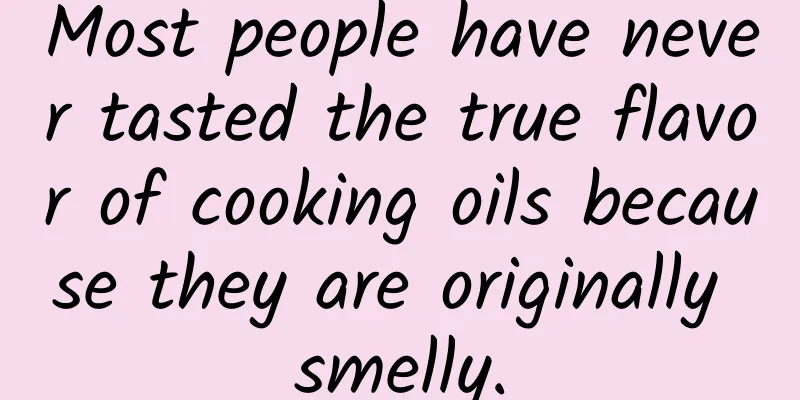Most people have never tasted the true flavor of cooking oils because they are originally smelly.

|
Key Points ★ The edible oil we eat does not stink because it has been deodorized. ★ The deodorization process is not complicated and has not changed much in more than a hundred years of development. ★ Some deodorization processes will increase the trans fatty acids in edible oils. Thermal deodorization accidents have caused 14,000 people to suffer from "oil disease"! Cooking oil is a must-have food in every household, and "grain and oil" itself is used to refer to staple food. However, most people don't realize that they have never tasted the real taste of cooking oil. This is because most cooking oils are originally smelly. Tuchong Creative A few cooking oils, such as sesame oil and peanut oil, have a pleasant original smell, but most cooking oils, such as rapeseed oil and rice bran oil, are not acceptable to everyone. However, except for a few vegetable oils such as sesame oil and peanut oil, the cooking oils we buy in supermarkets and shopping platforms now have almost no smell. Why is this? 01 The cooking oil we eat Why doesn't it smell bad? It turns out that the main component of vegetable oil and animal oil is called triglyceride. Triglyceride itself has no smell. The smell of unprocessed animal and vegetable oils comes from free fatty acids, aldehydes and other substances. The edible oils we usually use have undergone a "deodorization" process to remove most of the smelly substances. It is after the deodorization process that cooking oil looks and tastes the familiar bright golden and odorless color. In other words, most consumers don’t actually know what cooking oil tastes like in its original form. Unrefined (including deodorized) rapeseed oil (top row) and refined (bottom row) rapeseed oil. | doi.org/10.1371/journal.pone.0212879 M However, if you have a centenarian in your family, he or she may tell you that the cooking oil he or she ate when he or she was a child tasted very different from the taste now, because humans have only learned to deodorize cooking oil for less than 100 years. If you traveled back to 100 years ago, you might find the dishes of that time unpalatable. Cooking oil is essential for the delicious spicy hot pot. | Tuchong Creative At the beginning of the edible oil industry, that is, in the first half of the 19th century, people did not refine edible oil. Whether it was lard, butter or olive oil, they were eaten directly, and some people even liked these "original flavors" that had not been deodorized. But in the second half of the 19th century, the budding of the margarine industry in Europe made deodorization a necessity. 02 The long history of edible oil deodorization Margarine, also known as margarine, is hydrogenated oil. | Tuchong Creative At that time, margarine (also called margarine) was the now-maligned hydrogenated oil, which was made from vegetable oil. However, hydrogenated oil that had not been deodorized had a strong odor and was difficult to be accepted by the market. If the special odor of hydrogenated oil was not removed, margarine would not be convincing to consumers. American margarine advertisement, 1919 At the same time, there is also a demand for deodorization in the United States. After the cottonseed oil industry developed in the southern United States, the price of cottonseed oil became very low, and cottonseed oil manufacturers began to enter the food industry. At first, merchants would mix cottonseed oil with lard to make edible oil that was much cheaper than lard. However, because cottonseed oil smelled bad, many consumers did not buy it. Cottonseed and refined (including deodorized) cottonseed oil (below) | Tuchong Creative In this way, edible oil deodorization has become an industry necessity in Europe and the United States. As mentioned earlier, odor molecules are mainly composed of free fatty acids and other odor molecules. Because free fatty acids are more volatile than triglycerides, that is, oil itself, so as long as the temperature and air pressure are adjusted properly, the odor can be separated from the oil itself. According to the American Oil and Fat Chemists Society (AOCS), the principle of deodorization technology has not changed substantially in the past 100 years. The deodorization process usually involves passing a substance that removes odor molecules through hot oil in a low-pressure environment to remove the odor molecules in the oil. This odor-removing substance is called a stripping agent in the industry and is usually high-temperature steam (generally greater than 200 degrees Celsius). At the beginning, the mainstream deodorization equipment used in European edible oil was invented by E.Bataille and Lurgi. At the same time, many inventors also appeared in the United States. Deodorization equipment | Tuchong Creative In 1891, Henry Eckstein, an employee of the American NK Fairbank Co., invented the first edible oil deodorization equipment in the United States. His equipment also used high-temperature steam (about 160-175 degrees Celsius) to remove the unpleasant smell of cottonseed oil. Later, another American, David Wesson, invented a deodorization device in 1900, which also used the vacuum deodorization principle. The American Oil Chemists Association said that this was the most successful deodorization device in the United States, because Wesson's deodorized cooking oil became the global standard for cooking oil in the following decades. In fact, the important evaluation index of cooking oil refining loss is now called Wesson Loss (absolute loss value). 03 Thermal media "deodorization" It caused a terrible disaster! Although the deodorization principle has not undergone major changes, major public food safety accidents have occurred due to technical problems during the evolution of the deodorization process, and these accidents have also forced the reform of the deodorization process. These accidents are related to the notorious polychlorinated biphenyls (PCBs). PCBs were first manufactured and used in the United States in 1928. Because of their stable chemical properties and electrical insulation, PCBs are often used as heat carriers or insulating liquids. However, people later learned that PCBs are carcinogenic substances that easily accumulate in fat tissue, causing brain, skin and internal organ diseases, and affecting the nervous, reproductive and immune systems. In the 1920s and 1960s, edible oil refineries in the United States and Japan often used PCBs as heat transfer media for heating edible oil. The heat transfer media of the deodorization machines popular in the United States at that time were usually biphenyl and diphenyl ether, and the trademarks were usually Dowtherm A and Therminol VP-1. Old transformers often use PCBs as insulation materials, so they are an important source of PCBs. | Tuchong Creative Of course, under normal circumstances, PCBs are sealed in pipes and do not come into direct contact with cooking oil. However, in 1968, PCBs in deodorization equipment caused a public food safety incident that shocked the world. As a country where rice is the staple food, Japan has the habit of making and consuming rice bran oil. However, the free fatty acid content of rice bran is very high, so the smell is particularly strong. Many people cannot accept it without deodorization. So after the deodorization technology appeared, Japan also began to use deodorization equipment to deodorize rice bran oil. Rice bran (above) and refined (including deodorized) rice bran oil (below). | Tuchong Creative However, in January 1968, a heat medium pipeline at a rice bran oil refinery in Kyushu, Japan, ruptured, and polychlorinated biphenyls (PCBs) under the brand name Dowtherm A leaked out, contaminating the rice bran oil. The oil was then sold to consumers and chicken farmers, and between February and March 1968, 400,000 chickens died and 14,000 people became sick from eating rice bran oil contaminated with PCBs. Typical symptoms of the patients included darkening of the skin, the development of chloracne, the discharge of black oily secretions around the eyes and body, and children becoming stupid. Later, more than 500 people died from this. This is the famous "Oil Disease" incident. Chloracne on the face of a Japanese oily patient. | doi.org/10.1289/ehp.59-1568099 Because of the oil disease incident, the Japanese government later banned the use of Dowtherm as a heat medium and enacted the Chemical Evaluation Law in 1973. For the same reason, the United States later banned the use of PCBs as a heat medium in the deodorization process of edible oil. However, PCBs are difficult to excrete from the human body, and the disastrous consequences they cause can last a lifetime. That is why on August 29, 2011, Japan officially passed the Oil Disease Relief Law, which provides a legal basis for dealing with the aftermath of the accident 50 years ago. Due to numerous PCB pollution incidents including the Japanese rice bran oil incident, countries signed the Stockholm Convention in May 2001, requiring signatories to completely stop using polychlorinated biphenyls. The biggest impact of the oil disease incident on the deodorization industry is that in the deodorization step, high-pressure steam is mostly used when heating edible oil, and heat media has become non-mainstream due to safety hazards. 04 Non-thermal media "deodorization" is not perfect either Of course, the deodorization process, which rarely uses heat media, is not perfect. The deodorization process usually requires a high temperature of about 100-200 degrees Celsius. However, recent studies have found that such high temperatures can cause "thermal degradation" and cause the oil to produce some harmful substances, such as trans fatty acids. As the most in-demand oil in the world, palm oil has a particularly serious trans fatty acid problem. Unprocessed palm oil contains carotene, which makes it brown-red, not the white we see in instant noodle seasoning packets. Apparently, palm oil has also been bleached. Unprocessed palm oil is reddish brown, while refined palm oil is snow-white. | Tuchong Creative In fact, palm oil requires a special deodorization technology that can also decolorize it - heat bleaching. Heat bleaching usually requires a high temperature of 260 degrees Celsius, so the trans fatty acid product is more than other oils. In addition to environmental issues, this is also a major reason why palm oil products are criticized. Fried foods are usually made with palm oil. | Tuchong Creative Seeing this, while being amazed at the human technological progress contained in an ordinary bottle of vegetable oil, you may also be curious about the taste of the dishes cooked by the ancients. Dishes cooked with the colors and flavors of animals and plants are definitely not the same as those we make now with refined cooking oil and gas stoves. Editor: Jiang Fan Reviewer: Song Shuang Associate Researcher, Institute of Nutrition and Health, Chinese Center for Disease Control and Prevention Editor: Ding Zong Sources: Dudrow, FA "Deodorization of edible oil." Journal of the American Oil Chemists' Society 60.2 (1983): 272-274. Gavin, Arnold M. "Edible oil deodorization." Journal of the American Oil Chemists' Society 55.11 (1978): 783-791. www.alfalaval.com/globalassets/documents/local/china/industry/fwd_pft00355zh_degummingneu.pdf list.iupac.org/symposia/proceedings/Tunis04/degreytdeodorizationdgw.pdf www.shippai.org/fkd/en/cfen/CB1056031.html lipidlibrary.aocs.org/edible-oil-processing/deodorization Chakrabarti, Pradosh Prasad, and Ram Chandra Reddy Jala. "Processing Technology of Rice Bran Oil." Rice Bran and Rice Bran Oil. AOCS Press, 2019. 55-95. AAK & GreenPalm Palm Oil Guide.avi |
<<: 2021 Food Safety and Health Rumors List Announced
>>: "Togetherness" is passed down, there is a mystery behind the Beijing Winter Olympics medals!
Recommend
Mysterious "skull" pattern appears on preserved eggs? How did the strange "pine flower" pattern form?
There is a long-standing rumor that a peasant wom...
Hong Raiders Trend Emotion Hunting Hunting A Intensive Training Camp
Hong Raiders Trend Emotion Hunting Hunting A Stre...
360 privatization: Returning to A-shares to speculate and raise money or to reconstruct value?
After the war of words between Xiaomi and LeEco a...
How can brands operate Bilibili well?
Enterprise accounts are an important platform for...
Will watermelon and crayfish cause poisoning? Will watermelon and peach cause diarrhea? Are there so many rules for eating watermelon?
In the hot summer, people often feel the heat is ...
New media advanced operation growth practical training
Introduction to practical training resources for ...
The formula for creating popular educational short video content
As an account operator, I pray for the birth of a...
Youzituan's high-yield Baijiahao money-making project, simple operation to achieve a monthly income of 5000+
Youzituan's high-yield Baijiahao money-making...
Will the cybersecurity companies that disappeared in the mobile phone era become life firewalls in the field of smart cars?
Earlier this month, a piece of news once again ar...
8 tips for Apple Watch developers
[[130272]] Apple Watch is about to be released, w...
Volkswagen's all-electric MPV ID.Buzz is about to enter China. The price determines its fate. The 180,000 yuan model will be very popular, while the 300,000 yuan model will definitely fail.
In the era of new energy, many old rules of the g...
Zebra stripes, neither camouflage nor cooling? Uncovering the true purpose of black and white stripes
Did you know that the black and white stripes on ...
The four most common types of pimples on the hands, face, and neck may not be ordinary skin diseases!
When it comes to HPV (human papillomavirus), dise...
Flowers no longer have to take the blame, as they are actually the culprit for spring pollen allergies!
Sneezing, stuffy nose, rash... Do you have these ...









